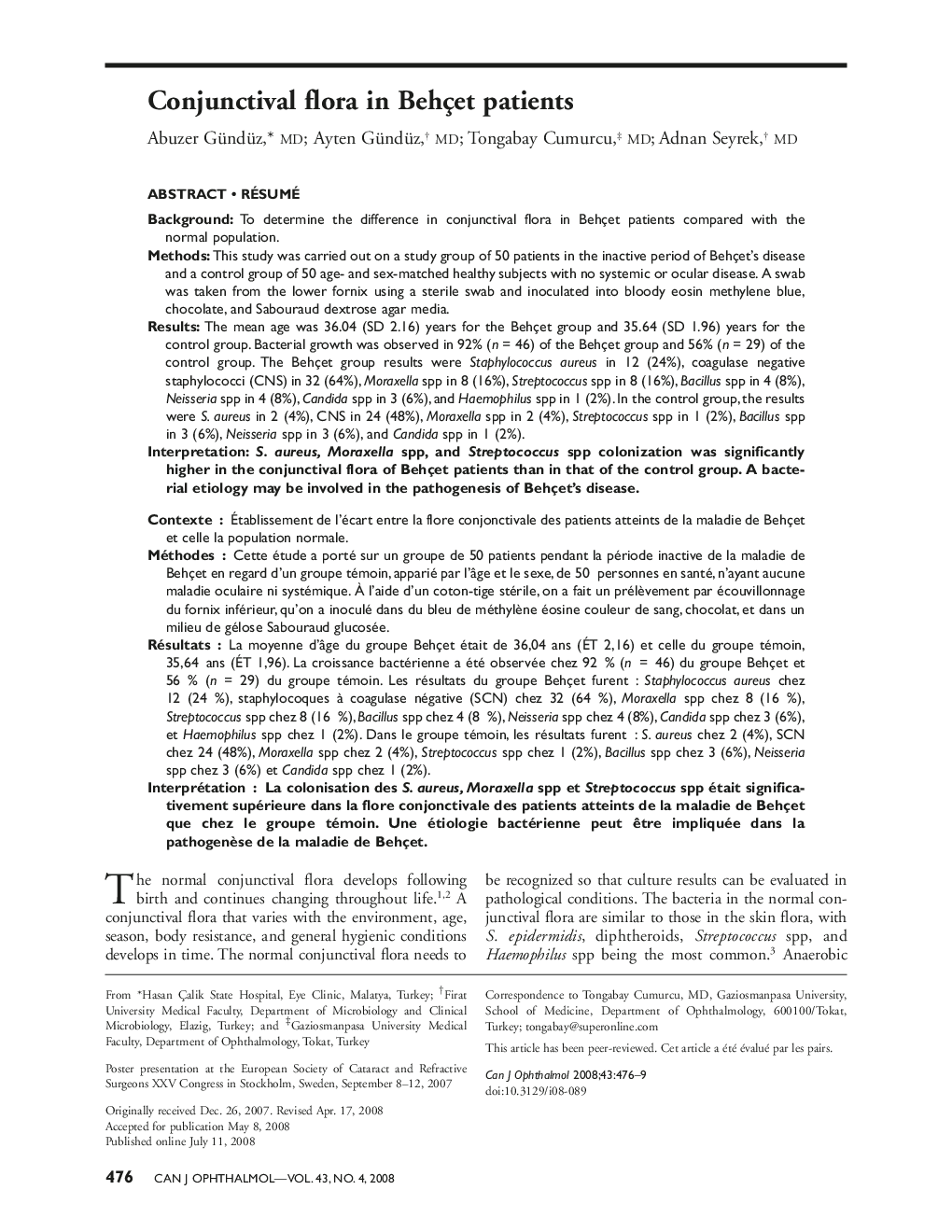| کد مقاله | کد نشریه | سال انتشار | مقاله انگلیسی | نسخه تمام متن |
|---|---|---|---|---|
| 4010485 | 1602442 | 2008 | 4 صفحه PDF | دانلود رایگان |

Background: To determine the difference in conjunctival flora in Behçet patients compared with the normal population.Methods: This study was carried out on a study group of 50 patients in the inactive period of Behçet’s disease and a control group of 50 age- and sex-matched healthy subjects with no systemic or ocular disease. A swab was taken from the lower fornix using a sterile swab and inoculated into bloody eosin methylene blue, chocolate, and Sabouraud dextrose agar media.Results: The mean age was 36.04 (SD 2.16) years for the Behçet group and 35.64 (SD 1.96) years for the control group. Bacterial growth was observed in 92% (n = 46) of the Behçet group and 56% (n = 29) of the control group. The Behçet group results were Staphylococcus aureus in 12 (24%), coagulase negative staphylococci (CNS) in 32 (64%), Moraxella spp in 8 (16%), Streptococcus spp in 8 (16%), Bacillus spp in 4 (8%), Neisseria spp in 4 (8%), Candida spp in 3 (6%), and Haemophilus spp in 1 (2%). In the control group, the results were S. aureus in 2 (4%), CNS in 24 (48%), Moraxella spp in 2 (4%), Streptococcus spp in 1 (2%), Bacillus spp in 3 (6%), Neisseria spp in 3 (6%), and Candida spp in 1 (2%).Interpretation: S. aureus, Moraxella spp, and Streptococcus spp colonization was significantly higher in the conjunctival flora of Behçet patients than in that of the control group. A bacterial etiology may be involved in the pathogenesis of Behçet’s disease.
RésuméContexte: Établissement de l’écart entre la flore conjonctivale des patients atteints de la maladie de Behçet et celle la population normale.Méthodes: Cette étude a porté sur un groupe de 50 patients pendant la période inactive de la maladie de Behçet en regard d’un groupe témoin, apparié par l’âge et le sexe, de 50 personnes en santé, n’ayant aucune maladie oculaire ni systémique. À l’aide d’un coton-tige stérile, on a fait un prélèvement par écouvillonnage du fornix inférieur, qu’on a inoculé dans du bleu de méthylène éosine couleur de sang, chocolat, et dans un milieu de gélose Sabouraud glucosée.Résultats: La moyenne d’âge du groupe Behçet était de 36,04 ans (ÉT 2,16) et celle du groupe témoin, 35,64 ans (ÉT 1,96). La croissance bactérienne a été observée chez 92 % (n = 46) du groupe Behçet et 56 % (n = 29) du groupe témoin. Les résultats du groupe Behçet furent: Staphylococcus aureus chez 12 (24 %), staphylocoques à coagulase négative (SCN) chez 32 (64 %), Moraxella spp chez 8 (16 %), Streptococcus spp chez 8 (16 %), Bacillus spp chez 4 (8 %), Neisseria spp chez 4 (8%), Candida spp chez 3 (6%), et Haemophilus spp chez 1 (2%). Dans le groupe témoin, les résultats furent: S. aureus chez 2 (4%), SCN chez 24 (48%), Moraxella spp chez 2 (4%), Streptococcus spp chez 1 (2%), Bacillus spp chez 3 (6%), Neisseria spp chez 3 (6%) et Candida spp chez 1 (2%).Interprétation: La colonisation des S. aureus, Moraxella spp et Streptococcus spp était significa-tivement supérieure dans la flore conjonctivale des patients atteints de la maladie de Behçet que chez le groupe témoin. Une étiologie bactérienne peut être impliquée dans la pathogenèse de la maladie de Behçet.
Journal: Canadian Journal of Ophthalmology / Journal Canadien d'Ophtalmologie - Volume 43, Issue 4, August 2008, Pages 476-479